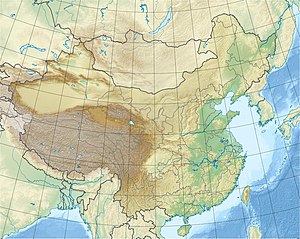Tianzhushan
| Tianzhushan 天柱山 |
||
|---|---|---|
|
Summit of Tianzhushan |
||
| height | 1760 m | |
| location |
|
|
| Dominance | 1642 km | |
| Coordinates | 30 ° 44 '30 " N , 116 ° 27' 27" E | |
|
|
||
| Type | Rock peaks | |
| rock | granite | |
The Tianzhushan or Tianzhu Mountain ( Chinese 天柱山 , Pinyin Tiānzhù Shān - "Heavenly Pillar Mountain") is a mountain range in the area of the independent city of Qianshan of the independent city of Anqing in the Chinese province of Anhui . It is located in the center of a nature reserve.
description
The Tianzhushan is located in the middle of a mountain landscape with 47 peaks that reach a height of over 1000 meters. The main summit is 1760 meters high. The landscape includes granite peaks, waterfalls, springs, numerous caves, as well as two rivers, Qianhe and Wanshui . The climate is foggy and humid with an average of 150 rainy days and annual precipitation of up to 1900 mm. The area is considered geologically and geohistorisch interesting as fossils and a collection of metamorphic , very dense eclogite has -Gestein as rare in open-minded is to find the form at the surface. The granite formations of the Tianzhushan originated in the Mesozoic Era . Since then, they have been significantly influenced and shaped by geological processes along the Tancheng-Lujiang Fault Zone ( 郯 庐 断裂带 , Tánlú Duànliè dài ). Compared with the 28 sites found worldwide up to 2008, where rocks formed under high pressure are found, the zone of the Sulu- Dabieshan belt, to which the Tianzhushan also belongs, is considered the largest.
The area has become a tourist destination due to its picturesque rock formations and varied landscape. The region is of cultural and historical interest, as the Xuejiagang ( 薛家 岗 ) site is located here, the only excavation site for Neolithic culture in Anhui to date. In addition, the region is considered a "cradle of Hui culture". The Sanzu Temple ( 三 祖 寺 , Sānzǔ Sì - "Temple of the Third Patriarch") located on the Tianshan , whose beginnings go back to the 5th century and which has been destroyed, rebuilt and rebuilt many times over the course of history, played an important role in teaching Buddhism in the region.
In the area of Tianzhushan there are rock inscriptions that span the 1173 years (822-1995) and all the ages included ( Tang , Song , Yuan , Ming and Qing dynasties , the Republic of China and the present).
Geopark and World Heritage Application
The area around the Tianzhushan has received increasing protection status over the years. It was promoted to a National Forest Park in 1982, a National Geopark in 2005 and a Global Geopark in 2011. On January 20, 2013, the area around the Tianzhushan was nominated by the People's Republic of China for inscription into the UNESCO World Heritage. The nominated area covers 338.02 km², including 225.3 km² of buffer zone. The World Heritage criteria (ii), (iii), (v), (vi), (vii), (viii) were given as justification . The area nominated for World Heritage is divided into two areas. The northern area, 102.72 km², contains granite formations, while the southern area, approximately 10 km², includes metamorphic rocks, paleontological fossils and the Xuejiagang site.
Web links
- Official website of the Tianzhushan Global Geopark
- Tianzhushan UNESCO Global Geopark on UNESCO's Global Geoparks website.
- Tianzushan on the UNESCO World Heritage Center website for tentative lists .
Individual evidence
- ↑ a b c d e Tianzhushan. UNESCO website, 2019, accessed on July 21, 2019 .
- ↑ Landform and Topography. english.tzsgy.com (Tianzushan Global Geopark), accessed on July 21, 2019 .
- ↑ Jonathan de Ferranti, Eberhard Jurgalski, Aaron Maizlish: CHINA IV: Central and Eastern China, Taiwan and Korea: 42 Mountain Summits with Prominence of 1,500 meters or greater. peaklist.org, 2006, accessed July 21, 2019 .
- ^ Climate and hydrologic conditions. english.tzsgy.com (Tianzushan Global Geopark), accessed on July 21, 2019 .
- ^ Buddhist and Buddhist Temple - The Sanzu Temple. english.tzsgy.com (Tianzushan Global Geopark), accessed on July 21, 2019 .
- ↑ Historic Evolution. english.tzsgy.com (Tianzushan Global Geopark), accessed on July 21, 2019 .


